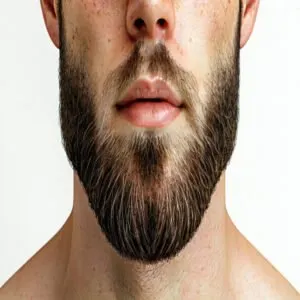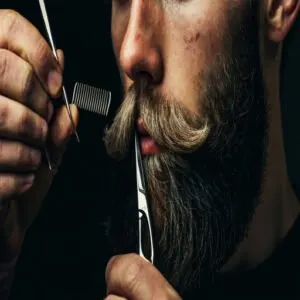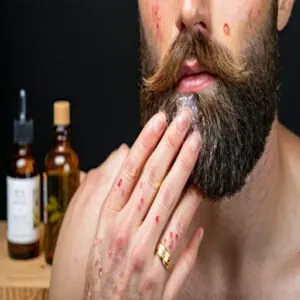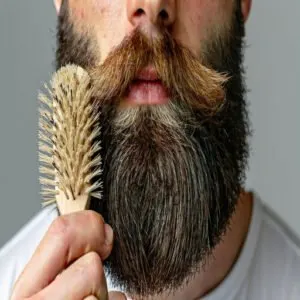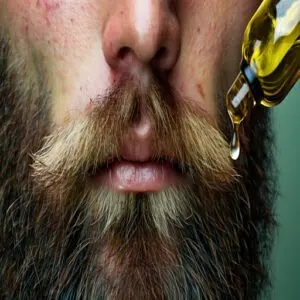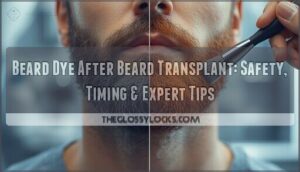This site is supported by our readers. We may earn a commission, at no cost to you, if you purchase through links.
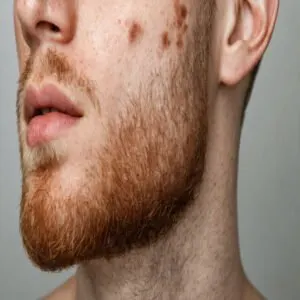
Your facial hair pattern is primarily influenced by genetics, but you’ve got several science-backed solutions in your arsenal.
Minoxidil, an FDA-approved treatment, can boost blood flow to your follicles, while microneedling creates ideal conditions for growth.
Don’t underestimate the power of lifestyle changes – proper sleep, stress management, and nutrition play important roles.
Think of your beard journey like tending a garden: with the right care and patience, those patches can transform into fuller growth.
Reaching your beard’s potential might be easier than you think.
Table Of Contents
- Key Takeaways
- Causes of Patchy Beards
- Foods for Beard Growth
- Proven Beard Growth Methods
- Beard Care and Grooming
- Medical Treatments Available
- Lifestyle Changes for Growth
- Frequently Asked Questions (FAQs)
- Can you fix patchy beard growth?
- Do patchy beards ever grow in?
- What is the 3 month beard rule?
- Is patchy beard due to low testosterone?
- How long should I grow my patchy beard?
- Can sunlight exposure affect beard growth patterns?
- Do beard growth supplements interact with medications?
- Is facial massage effective for stimulating beard growth?
- When do most mens beards stop filling in?
- Conclusion
Key Takeaways
- You’ll see the best results by combining FDA-approved treatments like 5% minoxidil and microneedling, as these treatments work together to boost blood flow to your facial hair follicles and stimulate new growth.
- Your lifestyle choices directly impact beard growth – prioritize 7-8 hours of sleep, regular exercise, and a nutrient-rich diet with foods high in vitamins A, B, D, and E to support healthy follicle development.
- You can enhance your existing beard’s appearance through proper grooming techniques – keep patchy areas trimmed shorter, exfoliate regularly to unclog follicles, and use a boar bristle brush to distribute natural oils evenly.
- You’ll need to commit to a consistent 3-4 month routine before seeing significant results, as beard follicles take time to respond to treatments, and what works best will depend on your specific growth patterns and genetics.
Causes of Patchy Beards
If you’re wondering why your beard looks more like a patchy quilt than a majestic mane, you’re not alone.
Genetics, hormones, medical conditions, and lifestyle choices all play a role in how your facial hair grows.
Your patchy beard pattern is likely influenced by a combination of these factors, from your DNA blueprint to your testosterone levels, and even your daily habits like diet and sleep.
Genetic Factors Influence
Eighteen genes play tag team with your beard growth, including heavy hitters like EDAR and FOXP2.
Your family history and genetic factors are like a blueprint for your facial hair growth patterns.
Think of your DNA as the director of your beard’s story – variations in genes like AR and FSHR affect how your follicles respond to hormones.
To learn more about beard growth genetics, understanding the role of genes is essential.
While you can’t change your genetic code, understanding it helps you work with what you’ve got.
Hormone Imbalance Effects
While your genes set the stage, hormone imbalances can throw a wrench in your beard-growing plans.
Recent studies show that low testosterone levels, especially after 45, can lead to patchy growth.
Your body’s androgen receptors and dihydrotestosterone levels play key roles too.
Understanding testosterone therapy can help address the root cause of patchy beards.
Hormone therapy might help, but it’s not a magic fix – alcohol, extra weight, and certain medications can still disrupt your natural testosterone balance.
Medical Conditions Impact
Beyond hormonal factors, several medical conditions can throw a wrench in your beard growth plans.
Alopecia areata and alopecia barbae, two autoimmune disorders, might cause sudden patchy hair loss in your beard area.
Other skin conditions like psoriasis can impact follicle health too.
If you’re noticing unusual patterns or sudden changes in your beard growth, booking a medical diagnosis could help identify these underlying health impacts.
Lifestyle Choices Matter
Your daily habits can make or break your beard game.
Poor sleep, skipping meals, and constant stress aren’t doing your patchy beard any favors.
Just like how medical issues affect growth, your lifestyle choices play a starring role.
Environmental factors like pollution, social pressures to look a certain way, and personal discipline in nutrition and exercise all impact how well your facial hair thrives, influenced by daily habits.
Foods for Beard Growth
You’ll be amazed at how your beard growth can transform when you fuel your body with the right nutrients, from protein-packed eggs to zinc-rich oysters that wake up those sleeping follicles.
Just like a garden needs the right soil and nutrients to flourish, your facial hair needs specific vitamins and minerals to grow thick and full.
And you’re about to discover the foods that’ll turn your patchy beard into a masterpiece.
Nutrient Rich Foods Benefit
From protein powerhouses to nutrient-packed superfoods, smart beard nutrition starts with the right ingredients.
Pack your plate with lean meats and fish for strong facial hair growth, plus berries that supercharge your follicles with antioxidants.
Throw in some spinach for that iron boost, and legumes for a natural nutrient boost that’ll turn those patches into a masterpiece of healthy eating with strong facial hair growth.
Vitamin and Mineral Importance
Looking to supercharge those beard growth vitamins?
Vitamins A and B work double-time, with A cranking up sebum production while B vitamins boost circulation to those hungry follicles.
Growth boosters like vitamin D balance hormones and trigger testosterone, while E acts as your beard’s personal bodyguard against damage.
Utilizing beard growth supplements can further enhance the effects of a balanced diet.
Healthy follicles thrive on a mix of beard nutrition – think fatty fish, nuts, and leafy greens for maximum growth potential.
Hydration and Sleep Role
Between water intake and sleep patterns, you’ve got the secret sauce for fixing that patchy beard.
Your daily routine should include drinking 8-10 glasses of water to maintain skin health and support the beard growth cycle.
Poor sleep quality can mess with hormone levels that drive facial hair growth, so aim for 7-8 hours of solid rest.
Keep your beard hydration game strong with consistent water breaks.
Proven Beard Growth Methods
You’ll be amazed to learn that science-backed treatments like minoxidil and microneedling can transform your patchy beard into a fuller, more impressive growth.
While genetics play a big role in your facial hair pattern, these proven methods can wake up those sleeping follicles and boost your beard game substantially.
Minoxidil Treatment Works
While good nutrition sets the foundation for beard growth, Minoxidil offers a scientifically-backed solution for your patchy beard woes.
This FDA-approved treatment works by boosting blood flow to your facial hair follicles, triggering impressive growth in most users.
- Apply 5% Minoxidil foam or liquid twice daily for best results
- Expect visible changes within 4 months of consistent use
- Treatment must be ongoing – stopping leads to hair loss
- Keep an eye out for side effects like skin irritation or unexpected hair growth
Microneedling Technique Benefits
Looking to boost your facial hair growth?
Microneedling might be your ticket to a fuller beard.
This beard growth treatment works by creating tiny channels in your skin that trigger collagen boost and hair stimulation.
For the best microneedling results, stick to a 0.5-0.75mm needle length – your face’s skin is actually thinner than your scalp.
To achieve ideal results, consider investing in a Microneedling Kit for consistent treatment.
You’ll notice improved facial rejuvenation as your patchy beard fills in gradually.
Peppermint Oil Stimulation
Ready to give your patchy beard a natural boost?
Peppermint oil isn’t just for fresh breath – it’s a powerhouse for beard growth stimulation.
Mix three drops with jojoba oil for a DIY beard-boosting blend that’ll wake up those sleepy follicles.
Studies show it outperforms traditional treatments, thanks to its circulation-boosting properties.
The peppermint oil benefits can be attributed to its ability to increase blood flow to the scalp.
Just remember: always dilute it first, or your face might feel like a mint factory explosion!
Derma Rolling Enhancement
While peppermint oil works its magic, adding a derma roller to your routine can supercharge your beard game.
This micro needling tool creates tiny channels in your skin, helping beard growth stimulators like minoxidil absorb better.
Start with a 0.5mm derma roller twice weekly for skin rejuvenation and hair follicle activation.
Just remember to sterilize your tool before each use—nobody wants a patchy beard AND an infection!
Beard Care and Grooming
You’ll be amazed at how proper beard care can transform those patchy spots into a masterpiece of facial art, even if your current beard looks like it’s playing hide and seek.
With the right grooming routine, you’re not just maintaining your beard – you’re creating the perfect environment for those reluctant follicles to finally show up and join the party.
Trimming and Shaping Importance
Looking to level up your patchy beard game?
The 2025 trend embraces natural-looking facial hair, but that doesn’t mean skipping smart sculpting.
Keep your beard at a moderate length while letting your mustache grow fuller.
Using quality trimming tools, focus on beard symmetry by maintaining shorter lengths in sparse areas.
Shape your facial hairlines strategically – it’s like being an artist with edge control as your brush.
Exfoliation and Cleaning Routine
Keeping that new trim looking sharp starts with proper skin care underneath.
Your daily beard cleansing routine should include gentle face washing and regular exfoliation to remove dead skin cells that can clog hair follicles.
Using a beard exfoliating scrub can help maintain healthy skin and promote beard growth.
Using facial massage and exfoliating tools twice weekly stimulates blood flow to patchy beard areas, while natural beard care products keep both skin and facial hair clean without over-drying.
Beard Brushing and Styling
Grab your boar bristle brush and start taming that facial hair with daily brushing sessions.
By working the brush against your beard’s grain, then with it, you’ll boost circulation and evenly distribute natural oils.
Use beard fillers to mask patchy spots while styling, and experiment with brush techniques to add volume.
Investing in a beard comb set can also enhance your grooming routine.
Remember, proper beard brushing isn’t just about looks—it stimulates growth and improves beard texture too.
Medical Treatments Available
You’ll be amazed at how modern medical treatments can transform your patchy beard into a fuller look.
From prescription-strength minoxidil to cutting-edge PRP therapy, your dermatologist can create a personalized treatment plan.
That targets your specific beard growth challenges within months.
Doctor Consultation Necessary
Let’s be real – sometimes beard care isn’t just about oils and brushes.
When you’ve tried everything and still see those patches, it’s time to get a pro’s take. A proper medical diagnosis can reveal if there’s more going on, like alopecia barbae or hormone imbalances.
- A trichologist can perform detailed hair follicle analysis to pinpoint growth issues
- Health assessments help identify underlying conditions affecting your beard
- Skin examination catches problems like dermatitis that regular grooming won’t fix
Minoxidil Application Benefits
Once your doctor gives you the green light, Minoxidil becomes your secret weapon against that patchy beard.
Recent studies show impressive beard thickening results with 5% Minoxidil, turning facial hair from sparse to spectacular through follicle activation.
You’ll typically see the first signs of hair regrowth within 4-6 months, with many guys reporting dramatic beard growth solutions by month 16.
PRP Therapy for Alopecia
While minoxidil offers a topical solution, PRP therapy takes beard growth to the next level.
This innovative treatment uses your own blood’s healing powers to tackle alopecia and patchy beards.
Here’s what you’ll get with PRP:
- A three-step process that extracts growth factors from your blood
- Targeted scalp injections that wake up sleeping follicles
- Natural stimulation that costs around $1,000 per session
The results? Many guys see thicker, fuller facial hair without harsh chemicals, which can be achieved through natural stimulation and the power of PRP therapy.
Supplement Options Available
Transforming your patchy beard starts with the right beard growth supplements.
Clinical studies show biotin and collagen peptides can boost hair thickness, while vitamin E improves circulation for better growth.
You’ll find these facial hair supplements packed with amino acids, omega fatty acids, and mineral boosters.
For a thorough guide, explore effective beard growth supplements.
Top beard growth enhancers combine herbal remedies with vitamin supplements, creating a powerful cocktail that supports your journey to fuller facial hair.
Lifestyle Changes for Growth
You’re about to discover how simple lifestyle tweaks can transform your patchy beard into a fuller, healthier masterpiece.
Your daily habits, from hitting the gym to catching those essential Z’s, work together like a beard-growing dream team to boost your facial hair game naturally.
Regular Exercise Benefits
Exercise isn’t just great for your body; it’s a beard growth powerhouse too.
By boosting testosterone and circulation, your follicles get the fuel they need. Regular exercise for hair can markedly improve the health of your beard follicles.
Try this simple routine:
- Cardio Workouts: Fire up blood flow.
- Strength Training: Elevates testosterone levels.
- Flexibility Exercises: Keeps stress low.
- Endurance Building: Encourages consistency.
Your beard will love your workout dedication!
Stress Reduction Techniques
Stress messes with beard growth by throwing hormones off balance.
Try relaxation techniques like yoga practice or mindfulness exercises to keep stress in check.
Deep breathing can feel weird at first, but it works wonders.
Meditation benefits your focus and stress reduction.
It’s like hitting pause on chaos—better stress management means happier hormones and a less patchy beard.
Sleep and Diet Optimization
If stress has you tossing and turning, it’s time to rethink your sleep patterns and dietary habits.
Prioritize your circadian rhythm by sticking to consistent bedtimes.
Add nutrient balance to your diet with lean protein, leafy greens, and omega-3s.
Meal timing matters too—avoid eating late, and skip sleep deprivation, embrace smart nutrition tips, and watch patchy spots improve.
Quitting Smoking and Limiting Alcohol
Boosting beard density isn’t just about what you eat—it’s also about what you quit.
Smoking slows blood flow, starving your hair follicles, while heavy drinking depletes nutrients essential for hair growth promotion.
Kicking nicotine with addiction support and trying alcohol detox lets your body rebuild Healthy Habits.
Patchy beard bothering you? Recovery tips like these set the stage for improved beard growth.
Frequently Asked Questions (FAQs)
Can you fix patchy beard growth?
Like a garden needing care, your patchy beard can flourish with the right approach.
You can improve growth through minoxidil treatments, proper nutrition, microneedling, and lifestyle changes that boost testosterone levels naturally.
Do patchy beards ever grow in?
Yes, patchy beards can fill in as you age and hormones stabilize.
You’ll notice changes between 25-35 years old, but genetics ultimately determine your beard’s fullness.
Some patches might remain permanently sparse.
What is the 3 month beard rule?
The 3-month beard rule says you should let your facial hair grow untouched for 13 weeks before making any major grooming decisions.
This waiting period reveals your natural growth pattern and potential.
Is patchy beard due to low testosterone?
Hold your horses – low testosterone isn’t the only culprit behind your patchy beard.
While it can affect growth, your beard’s patchiness might be due to genetics, stress, or poor nutrition too.
How long should I grow my patchy beard?
Let your patchy beard grow for 8-12 weeks to see its natural pattern.
You’ll notice fuller coverage as slower-growing follicles catch up, giving you a better idea of your beard’s potential.
Can sunlight exposure affect beard growth patterns?
Sunlight sensibly stimulates vitamin D production, which can positively impact your beard’s growth patterns.
Your facial hair follicles benefit from moderate sun exposure, but don’t forget to protect your skin from harmful rays, which is crucial for overall beard’s growth.
Do beard growth supplements interact with medications?
You’ll need to check with your doctor before starting beard supplements – ingredients like biotin and saw palmetto can interact with certain medications.
Don’t risk your health; get professional guidance for your supplement journey.
Is facial massage effective for stimulating beard growth?
While scientific evidence remains limited, facial massage may improve circulation.
Studies show it reduces stress and affects skin tissue, but there’s no strong proof it directly stimulates beard growth through follicle activation.
When do most mens beards stop filling in?
Most men’s beards reach full maturity between ages 25-35, though it varies by genetics.
Don’t lose hope if your beard isn’t complete by 20 – some guys see new growth into their mid-30s.
Conclusion
Rome wasn’t built in a day, and neither is the perfect beard.
By implementing these solutions for patchy beard growth, you’re taking control of your facial hair journey.
Whether you choose minoxidil, microneedling, or natural remedies, remember that consistency is key.
Make those lifestyle changes, nourish your body, and give your beard the time it needs to flourish.
With patience and the right approach, those patches will soon be part of your beard’s past.
- https://cremocompany.com/blogs/blog/how-to-fix-a-patchy-beard
- https://uk.braun.com/en-gb/male-grooming/beard-care/how-to-fix-a-patchy-beard
- https://www.beardresource.com/how-to-fix-patchy-beard/
- https://wimpoleclinic.com/blog/all-natural-ways-to-fix-a-patchy-beard/
- https://www.gq.com/story/how-to-fix-your-patchy-beard

